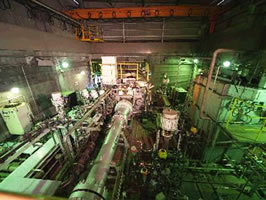Wind tunnel for a combustion test using a supersonic and hypersonic air-breathing engine model
This wind tunnel for a combustion test uses a supersonic and hypersonic air-breathing engine model, including for ramjets, scramjets and rocket based combined-cycle engines. It is also possible to conduct engine model tests under static atmospheric conditions.

| Department | Research Unit IV,Research and Development Directorate |
|---|---|
| Installation location | Kakuda Space Center |
| Measurement items | Pressure: 256 channels (electronic scanning type) |
Fuel supply |
Hydrogen gas Oxygen gas Ethanol |
| Test environment | Facility nozzle exit diameter: 51 cm x 51 cm (free jet) ◆Mach 8 flight conditions: Combination of thermal storage heating and combustion heating ◆Mach 6 flight conditions: Thermal storage heating or combustion heating ◆Mach 4 flight conditions: Thermal storage heating *Given the assumption for air flow after the shockwave passage from the front edge of the vehicle, the Mach number flight conditions and facility provision Mach number differ. |
| Year of completion | FY 1993 |
